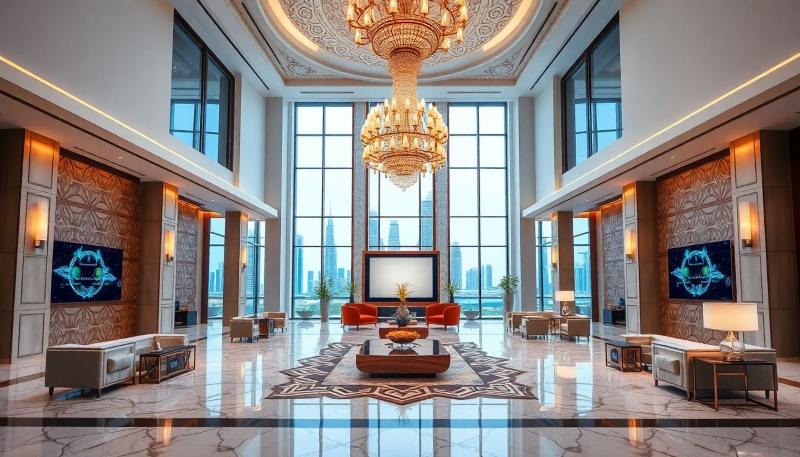In UAE comptitive business market, standing out is a challenge. Many brands fight for attention, but few think about how their spaces tell their story. Interior design is a secret weapon that shapes how people see a brand. It’s more than just pretty decor — it’s a way to connect deeply with customers. This article explores how smart interior design can boost brand image and loyalty across the UAE.
The Strategic Significance of Interior Design in Brand Identity
Understanding Brand Identity and Interior Design
Brand identity is what sets a business apart — the look, feel, and message it gives off. When it comes to physical spaces, interior design is a mirror of what your brand stands for. Think of it as a handshake before a conversation. The colors, furniture, layout, and atmosphere all reflect your core values and story. If your brand is luxury, your space should feel exclusive. If it’s eco-friendly, natural materials can tell that story visually.
The Impact of Interior Design on Consumer Perception
People react to environments more than we realize. The right design triggers positive feelings, trust, and even loyalty. In the UAE, consumers prefer spaces that are visually appealing and functional. Studies show that 70% of shoppers say their experience impacts how they see a brand. When interior design aligns with brand values, it leaves a lasting impression, encouraging customers to return.
Competitive Advantage through Unique Interior Branding
Many brands in Dubai, Abu Dhabi, and Sharjah use interior design to stand apart. Luxury hotels and high-end retail stores often create spaces that are unforgettable. For example, the Dubai Mall’s decor reflects the city’s grandeur and innovation. These spaces don’t just look good; they communicate who the brand is. This uniqueness makes customers associate the space with quality, boosting loyalty and brand recall.
Key Elements of Interior Design That Reflect Brand Values
Visual Identity and Spatial Layout
Colors, signage, and decor play a big role in reinforcing your brand. A teal color scheme can evoke calmness, while bold reds energize a space. Signage should be clear and consistent. The flow of space matters too — open layouts invite exploration, while cozy nooks create intimacy. How customers move through a space sends messages about your brand’s personality.
Material Selection and Ambient Conditions
In the UAE, luxury brands often use high-end materials like marble or gold accents to signal quality. Soft lighting and perfect acoustics make spaces inviting and memorable. Climate control is essential too, especially in the hot UAE weather. When designed well, these elements create an immersive experience that matches a brand’s promise of elegance or comfort.
Cultural Relevance and Local Context
Incorporating Emirati culture can strongly connect brands with local audiences. Using traditional patterns, art, or local crafts reminds customers of the region’s rich heritage. At the same time, brands can blend this with international design trends, making spaces feel both modern and rooted in local pride.
How Interior Design Enhances Customer Engagement and Loyalty
Creating Memorable Brand Experiences
Designing a space for a strong impression is key. Think of innovative retail setups in Dubai’s malls or themed restaurants that draw people in. These environments make customers feel special and encourage sharing on social media. A well-designed space becomes part of the brand story, making customers remember them longer.
Consistency Across Multiple Locations
If your brand has many stores or restaurants, the interior design must stay true everywhere. Consumers expect to see the same look and vibe, whether at Dubai’s airport lounge or a hotel in Abu Dhabi. Standardized design ensures that your brand’s identity remains strong no matter where customers visit.
Designing for Functionality and Customer Journey
A design isn’t just about looks; it must work well. Clear signage, smooth pathways, and comfortable seating improve the experience. When customers find it easy to navigate and enjoy their visit, they’re more likely to return. Good use of interior space turns casual visitors into loyal fans.
Trends and Innovations in UAE Interior Design for Branding
Sustainable and Eco-Friendly Design Solutions
More brands focus on green designs now. Using recycled materials and energy-efficient lighting shows they care about the environment. For instance, some Dubai hotels use solar panels and local, sustainable decor to match evolving customer values. Eco-friendly design is not just trendy; it’s a smart move for branding in the UAE.
Tech-Integrated and Smart Interiors
Smart spaces are on the rise. IoT devices, touch screens, and interactive elements make spaces more engaging. Some retail stores in Dubai now have virtual dressing rooms or digital walls, giving customers a high-tech experience. These innovations create buzz and showcase a brand’s modern edge.
Incorporating Art and Local Craftsmanship
Art can tell your brand story in a powerful way. Commissioned art pieces or local crafts add authenticity. Supporting Emirati artisans helps build a narrative of cultural pride. It’s a way to stand out while honoring local talent and tradition.
Practical Tips for Leveraging Interior Design to Build Brand Identity in the UAE
- Start with a clear brand audit. Know what you want your space to say.
- Work with designers familiar with UAE culture and trends.
- Focus on sustainability. Green design appeals to modern customers.
- Update interiors regularly to keep the brand fresh.
- Use design elements that tell your story—colors, textures, stories.
Conclusion
Interior design isn’t just decoration — it shapes how your brand is seen. In the UAE’s lively market, smart spaces can build trust, loyalty, and a strong reputation. Thoughtful, culturally relevant, and innovative interiors help brands stand out from the crowd. Investing in your space is investing in your brand. A well-designed environment turns visitors into loyal customers who remember your story long after they leave.

